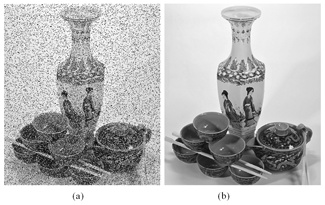Restoration of noisy images

The human visual system is very sensitive to high amplitude of noise signals, and such degradation of an image can result in subjective loss of information. So, the goal of our work is to recover an ideal high-quality image from data that are degraded by impulsive noise. Impulse noise (outliers) is usually characterized by abrupt alterations of intensity values in the input image (Fig. 1 (a)). Traditional filtering algorithms do not work very well in the case of impulsive noise, and effective techniques usually consist of two steps. First corrupted pixels might be detected and then a noise cancellation scheme is applied only to detected noisy pixels.
The main contribution of our work is to design of an effective outlier detector. Suppose that we mentally divide the noisy image (Fig. 1 (a)) into segments like outliers and non corrupted parts of the image. Note that in this case outliers segments generally much smaller than image segments (Fig. 2 (a) black or white pixels). If we can measure the number of pixels that belongs to the considered segment we can separate the corrupted segments from the uncorrupted ones. So to measure the proper number of the pixels in the considered segments we introduce in our paper a concept of Gradient Adaptive Neighborhoods (GAN). Let describe pixels of an image as cells. The edges that separate these cells may be represented as partitions or thin dams (see Fig. 2(b)). The heights of partitions are proportional to the absolute difference of adjacent pixels. When any pixel of the image is flooded by letting water to rise to a fixed level then several noncommunicating pools are formed (with unique level of water for each pool). Eventually the GANs are the obtained pools (or segments), and now it is very easy to calculate the amount of pixels that belongs to each segment.
Figure 1 (b) illustrates the result of an image restoration (from the corrupted image Fig. 1 (a)) using our outliers detector. This computer experiment shows that the proposed method has a strong ability in impulsive noise reduction and a very good preservation of fine structures and details.
References
Mozerov M, Kober V, "Impulse noise removal with gradient adaptive neighborhoods", OPTICAL ENGINEERING, 45 (6): 67003-67003


